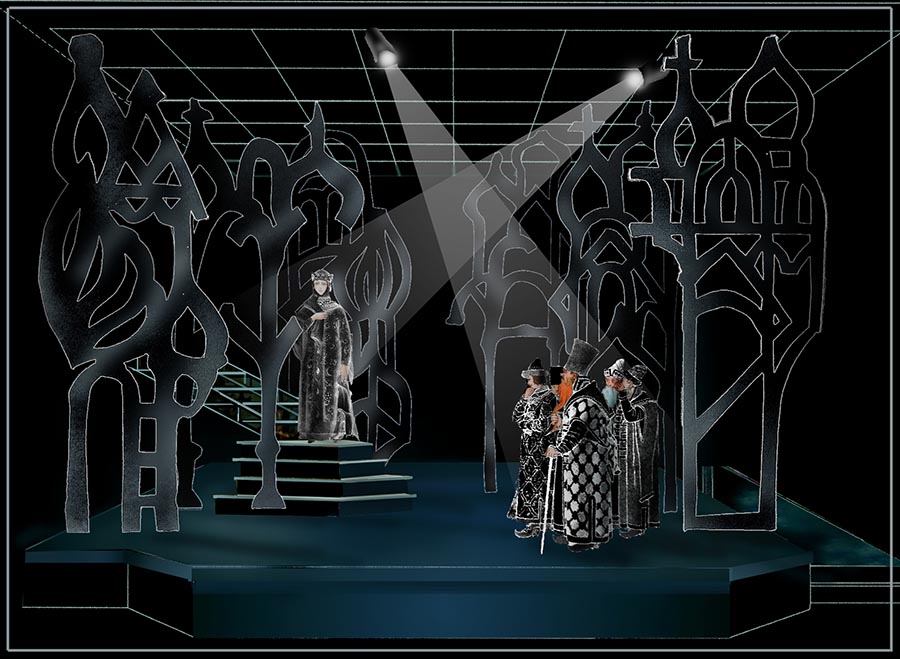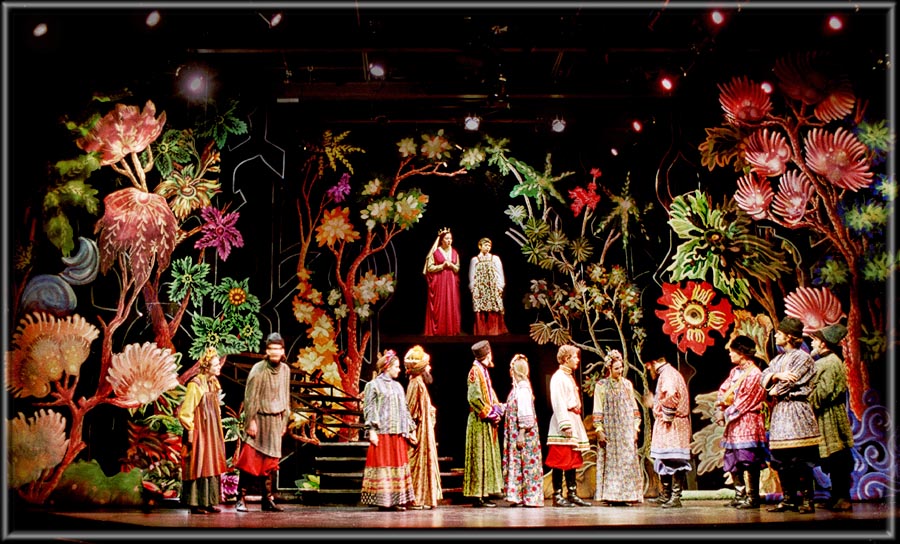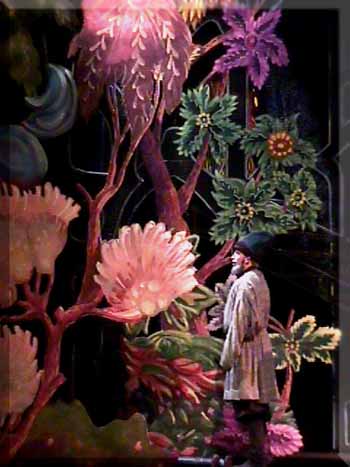In their work, Shakespeare in Performance,
Consultant Editors Keith Parsons and Pamela Mason succinctly sum up
the theme of the work as well as it�s relation to setting:
"Explorations of love lie at the heart
of As You Like It. Set in two principal locations, the rigid
hierarchical patriarchy of a usurped court and the unstructured and
pastoral potentiality of the Forest of Arden."
Clearly, Shakespeare intended to set up tow
opposing worlds and ideals. The world of the court is cold, dark, and
devoid of honor. It is stiff and rigid. The world of Arden, in the
pastoral tradition, is a world of possibility. It is a world of light
and DE-light. It is a world of color. But most of all, it is a world
with immense power to heal and to restore the balance of nature.
In mounting the production, we wanted to find
a parallel set of opposing worlds from within history. The
production�s director, Kathy Maes, was struck by exactly such
parallels in the history of Russian culture, particularly in the time
of Ivan. It was a time in Russian history where brother was indeed set
against brother. It was a dark time of power struggles and court
intrigue.
By contrast, Russian folk art from this
period and later was typified by light, bright colors, rich organic
line, beautiful patterning, and delicacy.
We adopted these contrasting worlds in our
setting, and worked to emphasize that contrast.
First, Kathy Maes re-worked the script so
that the action would not move back and forth between the two worlds.
In our edition the action begins in the court and moves to Arden in
the midst of our first act. There the action remains.
The goal was to better emphasize the
transformation that the new environment and its inherent ideals brings
to the characters in the work.
So in our own very limited environment, we
sought to create two worlds of maximum contrast by which
transformation could happen in a most magical, theatrical way.
In this regard, the court scenes were staged
in a setting marked by its starkness, blackness, coldness. It was a
minimal setting, colorless, with carefully chosen forms to indicate
the environment of the Russian Court in as stark a manner as possible.
In this setting, the environment of the Acoma theatre itself was not
hidden. The setting was not outside of the expectations of the
traditional audiences to that space.
Audiences at The Acoma are not used to any
kind of scene changes, let alone transformational ones. The theatre
includes no proscenium, no fly space, no wing space, and no way to get
scenery out from backstage. The environment of the Acoma in its most
natural form, seems to parallel that of the court - an environment of
rigid expectation.
We wanted to set expectations on their head
through a transformational change of setting, that would transform the
space itself. We did so through the employment of layers of roll cut
drops. These were patterned after the lively folk - arts and the
lacquer paintings one finds from artists in villiages such as
Fedoskino, Palekh, Kholui, and Mstera. It is as though the court is
the blank, black lacquer box, devoid of life, while the Arden scenery
provides the environment that transforms the box into one of light and
life.
We hid the stored roll-drops well within the
lighting equipment on the pipe grid. When the drops came into view it
was indeed a total and magical transformation of the space. While roll
drops and cut drops are common in our scenic heritage, I suspect it
was somewhat of an innovation to combine the two technologies. In any
event rolling an uneven cut drop proved to be a highly difficult task.
But keeping the cut-drop strategy allowed for a wonderful integration
of performer and costume within the painted elements of Arden.
Here the photograph is deceptive. At the
Acoma, no audience member is farther from the stage than about 30
feet. We created a very dimensional environment, with many layered
playing spaces. While colors matched between performer costumes,
lighting, and set elements, separation in the 3-d space was always
crisp. The 2-D photograph artificially flattens the stage image in a
way not experienced by actual audiences.
In lighting, I worked too towards contrast
and transformation, within our very limited set of resources. The
court scenes were typified by highly dimensional lighting. Most
lighting was from backlight and high side-lighting angles. The
coloration was in the steel-cool side of the spectrum but not overly
colorful. As I didn�t have the resources for a double hang, I used
cool side light from one side and a cool lavender from the other (the
lavender could also work with the warmer colors in Arden). The
lighting in the court was also marked by pools and zones of light.
Actors would move through light and shadow. In lighting, this was a
world of contrast and lower intensity of lighting. The contrast of the
lighting kept things stark. The gloss black of the environment,
coupled with the side lighting angles, gave a feeling of
disjointedness to the performer. Each performer seemed to float
independent of each other and of setting.
The world of Arden contrasted in most every
way in the lighting. Arden was bright, and colorful. While side and
backlight was still important to provide dimensional separation from
the drops, there was much more front lighting to mitigate stark
shadows, to provide a feel of brightness, and to bring out the
coloring of costumes and scenery. Since the colorful nature of the
environment was accomplished primarily through scenery and costume
elements, the lighting itself did not use saturated colors, but rather
colors that would enhance the natural colors of the pigments of the
set and costumes. In contrast though to the cool tones of the court,
the environment of Arden made use of generally warm tones in lighting.



